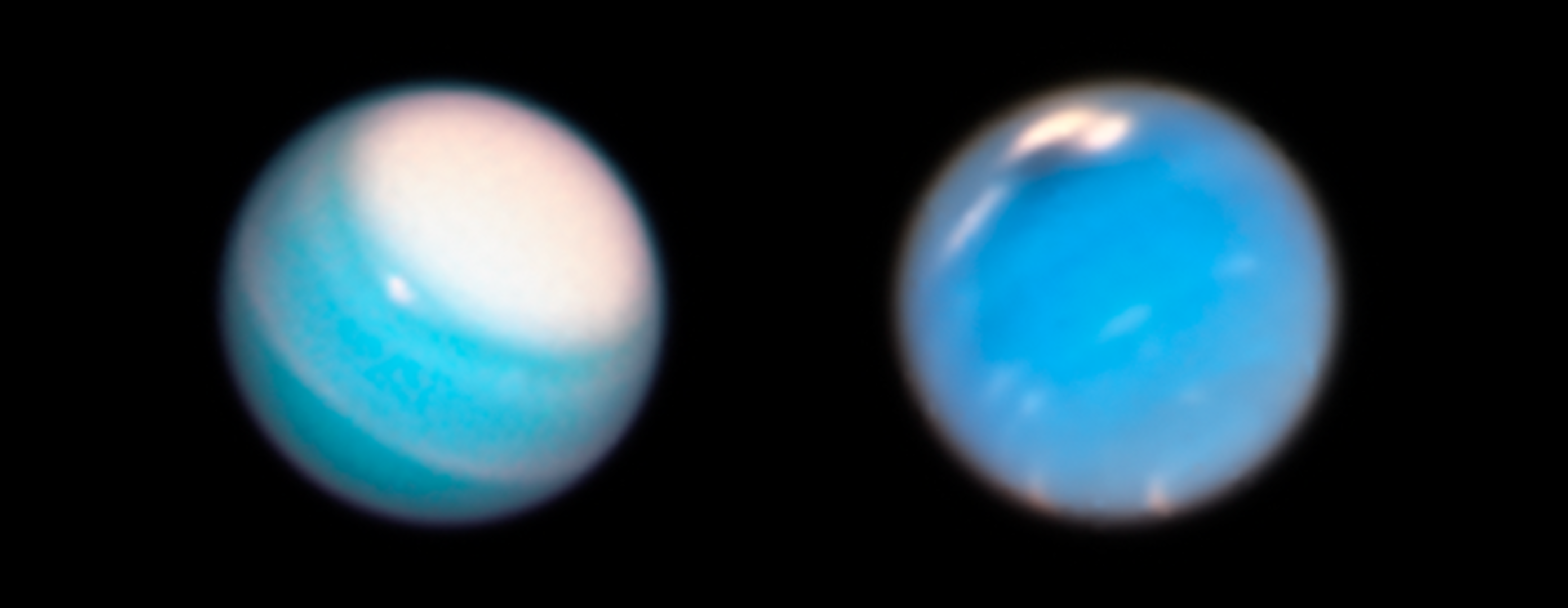Blue marbles
Sitting beyond Jupiter and Saturn in our Solar System, these two planets have only been visited once by a spacecraft, albeit briefly. NASA’s Voyager 2 spacecraft swung by Uranus in 1986, and Neptune in 1989, snapping the only close-up detailed images of these distant worlds.
The first images of Neptune revealed a planet with a dynamic atmosphere, including two mysterious dark vortices. Uranus, however, appeared featureless. But these views were just one-time snapshots: they couldn’t capture how the planets’ atmospheres change over time.
Enter the Hubble Space Telescope, which has been making a roughly annual check-up of these distant worlds as they go through protracted seasonal changes in their multi-decades-long orbits – a year on Uranus is 84 Earth years, while Neptune takes 165 of our years to orbit the Sun.
The latest pair of Hubble images are presented here, displaying Uranus (left) alive with activity and Neptune (right) showing off a new dark storm.
The vast bright polar cap across the north pole dominates the image of Uranus. The cap, which may form due to seasonal changes in atmospheric flow, has become much more prominent than in previous observations dating back to the Voyager 2 flyby, when the planet, in the throes of winter, looked bland.
Scientists believe this feature is a result of Uranus’ unique rotation. Unlike every other planet in the Solar System, Uranus is tipped over almost onto its side. Because of this extreme tilt, during the planet’s summer the Sun shines almost directly onto the north pole and never sets. Uranus is now approaching the middle of its 21 year-long summer season and the polar-cap region is becoming more prominent.
Near the edge of the cloud cap is a large cloud of methane ice, while a narrow cloud band encircles the planet north of the equator. It is a mystery how bands like these are confined to such narrow widths, because Uranus and Neptune have very broad westward-blowing wind jets.
The latest images show that Neptune has a new swirling dark storm spanning nearly 11 000 km across – roughly equivalent to the distance between Lisbon, Portugal and Tokyo, Japan. It is accompanied by bright white ‘companion clouds’ formed when the flow of ambient air is perturbed and diverted upward over the dark vortex, causing gases to freeze into methane ice crystals. Like Jupiter’s Great Red Spot, the dark vortices swirl in an anti-cyclonic direction and seem to dredge up material from deeper levels in the ice giant’s atmosphere.
Both Uranus and Neptune are classified as ‘ice giant’ planets, which are fundamentally different to the gas giants like Jupiter and Saturn. They have no solid surface but rather layers of hydrogen and helium surrounding a water-rich interior, itself perhaps wrapped around a rocky core. Atmospheric methane absorbs red light but allows blue-green light to be scattered back into space, giving each planet a characteristic cyan hue.
Analysing these worlds will help scientists better understand the diversity and similarities of the planets in our own Solar System as well as the thousands of exoplanets discovered in other solar systems – the vast majority of which fall into the size range of Neptune and Uranus.
Indeed, ESA’s upcoming exoplanet mission Cheops will focus on analysing stars that are known to host Earth to Uranus- and Neptune-sized planets, providing a first step-characterisation into the nature of these alien worlds.
Given a favourable alignment of Jupiter to provide gravity assists in the late 2020s-early 2030s, NASA and ESA have also been studying concepts to send a mission to the ice giants to better understand this little-understood class of planets.
This images were captured in late 2018 as part of the Outer Planet Atmospheres Legacy (OPAL) program, and first published on 7 February 2019.This caption is based on the original release.


